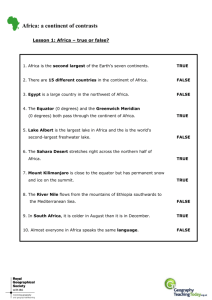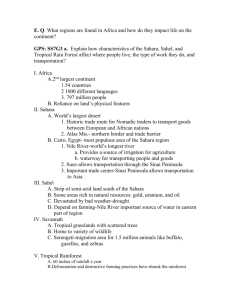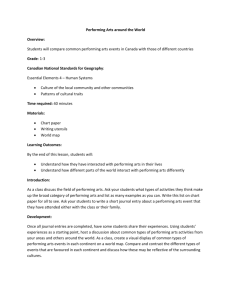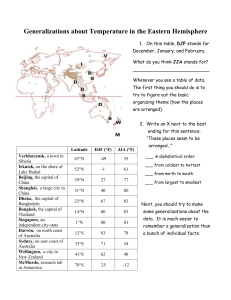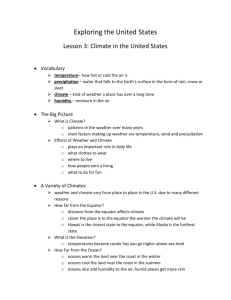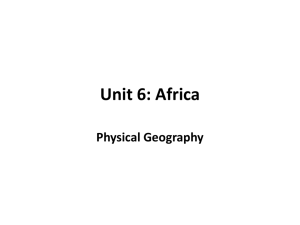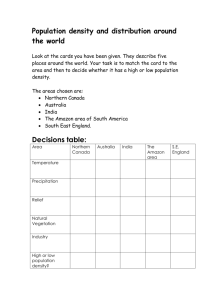Precipitation and the Inter Tropical Convergence
advertisement
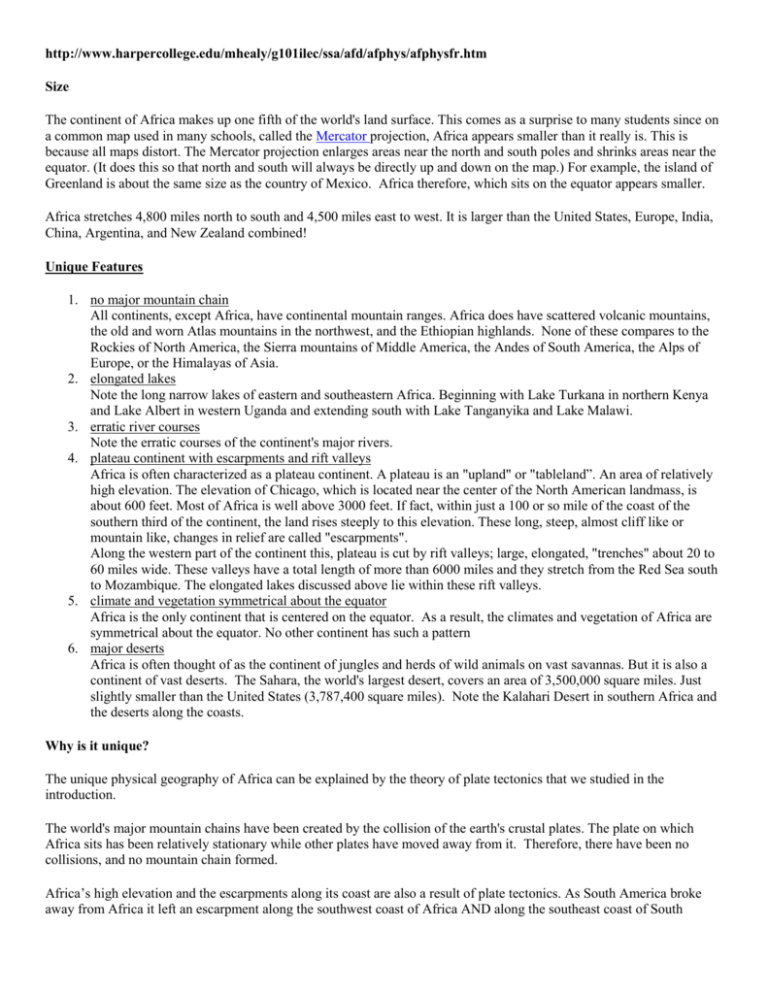
http://www.harpercollege.edu/mhealy/g101ilec/ssa/afd/afphys/afphysfr.htm Size The continent of Africa makes up one fifth of the world's land surface. This comes as a surprise to many students since on a common map used in many schools, called the Mercator projection, Africa appears smaller than it really is. This is because all maps distort. The Mercator projection enlarges areas near the north and south poles and shrinks areas near the equator. (It does this so that north and south will always be directly up and down on the map.) For example, the island of Greenland is about the same size as the country of Mexico. Africa therefore, which sits on the equator appears smaller. Africa stretches 4,800 miles north to south and 4,500 miles east to west. It is larger than the United States, Europe, India, China, Argentina, and New Zealand combined! Unique Features 1. no major mountain chain All continents, except Africa, have continental mountain ranges. Africa does have scattered volcanic mountains, the old and worn Atlas mountains in the northwest, and the Ethiopian highlands. None of these compares to the Rockies of North America, the Sierra mountains of Middle America, the Andes of South America, the Alps of Europe, or the Himalayas of Asia. 2. elongated lakes Note the long narrow lakes of eastern and southeastern Africa. Beginning with Lake Turkana in northern Kenya and Lake Albert in western Uganda and extending south with Lake Tanganyika and Lake Malawi. 3. erratic river courses Note the erratic courses of the continent's major rivers. 4. plateau continent with escarpments and rift valleys Africa is often characterized as a plateau continent. A plateau is an "upland" or "tableland”. An area of relatively high elevation. The elevation of Chicago, which is located near the center of the North American landmass, is about 600 feet. Most of Africa is well above 3000 feet. If fact, within just a 100 or so mile of the coast of the southern third of the continent, the land rises steeply to this elevation. These long, steep, almost cliff like or mountain like, changes in relief are called "escarpments". Along the western part of the continent this, plateau is cut by rift valleys; large, elongated, "trenches" about 20 to 60 miles wide. These valleys have a total length of more than 6000 miles and they stretch from the Red Sea south to Mozambique. The elongated lakes discussed above lie within these rift valleys. 5. climate and vegetation symmetrical about the equator Africa is the only continent that is centered on the equator. As a result, the climates and vegetation of Africa are symmetrical about the equator. No other continent has such a pattern 6. major deserts Africa is often thought of as the continent of jungles and herds of wild animals on vast savannas. But it is also a continent of vast deserts. The Sahara, the world's largest desert, covers an area of 3,500,000 square miles. Just slightly smaller than the United States (3,787,400 square miles). Note the Kalahari Desert in southern Africa and the deserts along the coasts. Why is it unique? The unique physical geography of Africa can be explained by the theory of plate tectonics that we studied in the introduction. The world's major mountain chains have been created by the collision of the earth's crustal plates. The plate on which Africa sits has been relatively stationary while other plates have moved away from it. Therefore, there have been no collisions, and no mountain chain formed. Africa’s high elevation and the escarpments along its coast are also a result of plate tectonics. As South America broke away from Africa it left an escarpment along the southwest coast of Africa AND along the southeast coast of South America. As India broke away from Africa it left an escarpment along the southeast coast of Africa AND along the southwest coast of India. (This escarpment is the "Western Ghats" mountains.) Currently, East Africa is breaking away from the rest of Africa creating the rift valleys that extend from the Red Sea in Eritrea through Kenya, Zaire, and Malawi. Part of these rift valleys have filled with water forming Africa's characteristic elongated lakes. The erratic river courses are also the result Africa's plateau characteristic with few mountains and a relatively level surface. Africa's Isolation WHY DO WE CARE? Africa's physical geography helps explain Africa's isolation from the rest of the world until the 19th century. (Remember, Columbus came to America at the end of the 15th century, 300 years earlier.) Except for a few coastal ports, Europeans knew little of Africa before then. Why? A quick look at the map will help us [Isolation]. Note the deserts, escarpments and waterfalls along much of Africa's coast. Furthermore, there are few good harbors. These features, along with Africa's great size and the existence of diseases, prevented the easy exploration of Africa's interior. http://geography.howstuffworks.com/africa/geography-of-africa.htm/printable Land Despite its great size, Africa does not have a great variety of physical features. Nearly the entire continent consists of vast plateaus the surfaces of which lie at varying elevations and are generally rolling to flat. Rarely are the plateau surfaces rough. The plateaus' edges, however, especially the eastern and the southern ones, are marked by sharp escarpments (mountainous walls) that descend to narrow plains along the coast. There are few broad coastal plains comparable to those of most other continents. Underlying the continent, and in many areas exposed, is an ancient block of stable crystalline rock. Along the southern margin of the Sahara are three immense basins: Djouf, through which runs the Niger River; Chad, containing Lake Chad; and Sudan, centered on the junction of the Blue and the White Nile rivers. Flanking all three basins are tablelands. Those inland from the Gulf of Guinea coast, such as the Fouta Djallon in Guinea and the Jos Plateau in Nigeria, have deeply eroded seaward slopes. The Congo Basin, in central Africa, is almost surrounded by plateaus, the highest being the East African Plateau. The basin contains most of the broad Congo River valley, which narrows abruptly in the Crystal Mountains near the Atlantic coast. East and south of the Sudan and the Congo basins are the highest plateaus on the continent. There are considerable expanses of almost level tableland in the interior, especially in Tanzania, Zambia, and South Africa. The interior's only large basin, the Kalahari, is in the southwest. Through the eastern part of the plateau region, from northern Ethiopia into Mozambique, runs the Great Rift Valley, a series of deep trenches caused by faulting, or fracturing, of the earth's surface. In several areas, steep sides of the valley appear as mountains, among which are the Ruwenzori Mountains in central Africa. Associated with the faulted valleys are numerous volcanoes, including Africa's two highest peaks— 19,340-foot (5,895-m) Kilimanjaro in Tanzania and 17,058-foot (5,199-m) Mount Kenya in Kenya. Along the east and southeast coast, high plateau edges form a series of escarpments. The loftiest of these, reaching 11,000 feet (3,350 m), is South Africa's Drakensberg. In the southwest, along part of the coast, lies the Namib Desert. Water Rivers cut through all parts of the continent except the Sahara, where rains are extremely infrequent. Only the Nile— longest river in the world—survives the desert path to the sea. The well-watered equatorial regions are drained mainly by the Congo River, which carries more water than any river but the Amazon of South America. The chief river of western Africa is the Niger; the Orange, Zambezi, and Limpopo systems drain most of the south. Many of the rivers have falls and cascades that limit navigation but provide great hydroelectric potential. Most important are Victoria Falls, on the Zambezi River, and Boyoma (formerly Stanley) Falls, a series of cataracts on the Congo River. The principal lake region is in the Great Rift Valley, where several large, narrow lakes lie between steep valley walls. These include Lakes Albert, Tanganyika, and Nyasa (or Malawi). Lake Victoria, on the broad plateau between branches of the Great Rift Valley, is Africa's largest lake and the chief source of the White Nile. The only large natural lake outside eastern Africa is Lake Chad, on the southern edge of the Sahara. Its size varies, depending on seasonal rainfall. Climate Since average annual temperatures are high nearly everywhere in Africa, division of the continent into climatic regions is based chiefly on amount and seasonal distribution of rainfall. Tropical Rainy The tropical rainy climate exists in only a comparatively small part of Africa. It occurs in a band 700 miles (1,100 km) wide along the Equator, ending at the highlands of eastcentral Africa. There are also narrower belts along the Gulf of Guinea, which has strong monsoonal influences, and along the east Madagascar coast. These areas are extremely humid, though not excessively hot. Temperatures remain near 80° F. (27° C.), with little variation seasonally and from day to night. All months are rainy, some more so than others. Annual amounts of precipitation vary from 60 inches (1,500 mm) inland to 130 inches (3,300 mm) or more along the coasts. Tropical Savanna Away from the Equator rainfall decreases and a distinct dry season develops during the cooler parts of the year —the period when the sun is on the opposite side of the Equator. Lasting as long as six months, the dry period is this climate's most distinguishing feature. Rainfall totals 20 to 60 inches (500 to 1,500 mm) a year. There is a slightly greater seasonal range in temperature here than in the tropical rainy regions. Much of eastern and southern Africa has a modified savanna climate, with slightly lower temperatures because of increased elevation. This kind of climate is typical of regions with savanna-type vegetation. Tropical Steppe Bordering the tropical savanna is the tropical steppe climate. It is more seasonally extreme in both temperature and rainfall than is the savanna. The warmest month averages more than 85° F. (29° C.), the coolest as low as 60° F. (16° C.). Average annual rainfall varies from 10 to 20 inches (250 to 500 mm). Tropical Desert A relatively large part of Africa has a tropical-desert type of climate. In such a climate, temperature ranges are greatest, for the bare to sparsely covered land heats and cools rapidly under cloudless skies. Daytime temperatures during the hotter months often exceed 100° F. (38° C.); occasionally they rise above 130° F. (54° C.). The coolest month averages 50° to 60° F. (10° to 16° C.) during the day, though freezing weather may occur at night. Average yearly rainfall does not exceed 10 inches (250 mm) anywhere; some areas go without rain for years. Mediterranean Mild average annual temperatures, dry summers, and moderately rainy winters are the chief marks of the Mediterranean climate. It occurs along part of the northern and southern coasts, where climatic influences from the middle latitudes are felt. During the warmest month temperatures average slightly above 70° C. (21° C.) near the coast and about 80° F. (27° C.) inland. Temperatures for the coolest month are roughly 50° F. (10° C.) and 60° F. (16° C.), respectively. The annual rainfall is about 20 to 30 inches (500 to 750 mm.) Humid Subtropical Part of the southeastern coast has a humid subtropical climate, which in temperature is similar to the Mediterranean type. Yearly rainfall, however, reaches 40 to 60 inches (1,000 to 1,500 mm) and is concentrated in the summer rather than the winter months. Highland In the highland regions, especially the loftiest sections of eastern Africa, temperatures are much lower than in areas of comparable latitude at lower elevations. This is particularly true in the Ethiopian Highlands and in some of the Rift Valley mountains. In areas of sharp relief lying in the path of moisture-bearing winds, rainfall is heavy. Mining The discovery of diamonds in southern Africa in the late 19th century signaled Africa's rise as a major mineral producer. The continent supplies about half of the world's diamonds as well as large quantities of gold, copper, chromite, cobalt, manganese, antimony, phosphate rock, asbestos, and platinum. Bauxite, tin, iron ore, uranium, tungsten, lead, zinc, silver, vanadium, and coal are also mined. In most African countries, the utilization of mineral resources has proceeded more rapidly than has any other economic activity. But mining on a large scale requires complex machinery, skilled technicians, and heavy financial investment, and few countries can afford to exploit their resources fully. The bulk of Africa's minerals, excluding fuels, is produced by four countries—South Africa, the Democratic Republic of the Congo, Zimbabwe, and Zambia. From these countries come diamonds, gold, copper, cobalt, and a variety of other minerals. Other countries that are major world producers of certain minerals include Botswana and Namibia (diamonds), Morocco (phosphate rock), Ghana (gold), Niger (uranium), and Guinea (bauxite). Nigeria, Libya, and Algeria are major producers of petroleum. Besides its direct benefits, mining has had important secondary effects. It has introduced wage labor; encouraged road and railway building; and stimulated the development of processing industries and hydroelectric power. http://www.pbs.org/wnet/africa/explore/sahel/sahel_overview.html The Sahel For centuries, the Sahel boasted some of Africa's most influential civilizations. A narrow band of semi-arid land south of the Sahara, the Sahel attracted both Arabs looking for gold from Sudan and Europeans looking for slaves from West Africa. The two influences merged with native ones, creating a culturally complex area. The Sahel is widely Frenchspeaking, Islamic and takes its name ("shore") from Arabic. But the region, one of the poorest and most environmentally damaged places on earth, has deep troubles. In the 1970s, the Sahel captured international attention when drought and famine killed nearly 200,000 people. Though conditions have since improved, it has yet to shake a vicious cycle of soil erosion, insufficient irrigation, deforestation, overpopulation, desertification and drought. Parts of the region -- like Mali's legendary Timbuktu -- are now more Sahara than Sahel. As the environment has suffered, the scramble for income has intensified. Ethnic lines that divided many traditional occupations -- herders and farmers -- have blurred, often sparking bloodshed. Instead of sticking to the land, rural workers are now heading for the cities. Dakar (Senegal), Ougadougou (Burkina Faso), Niamey (Niger) and Bamako (Mali) now hold about 25 percent of the Sahel's population and each year grow by another five percent. Open sewers are common, and electricity, running water and trash collection all too infrequent. To ease the strain, the Sahel's land must be restored, international development agencies believe. Ambitious tree-planting and irrigation projects dot the Sahel, fueling hopes. Will they succeed? For now, the answer remains in doubt. Inter-tropical Convergence Zone The motion of the Hadley cell, which is driven by intense solar heating, induces the formation of the ITCZ, which provides precipitation for rainforests. ITCZSource: MSN Encarta Graphic Model: http://people.cas.sc.edu/carbone/modules/mods4car/africa-itcz/index.html Precipitation and the Inter Tropical Convergence Zone (ITCZ) The most important component of climate is precipitation, because rainfall provides water for survival. Equatorial regions have extremely regular annual and inter-annual (short-term and long-term) patterns of rainfall. These regions include the rain forest areas of Cote d'Ivoire, Ghana, Togo, Cameroon, the Central African Republic, and parts of both the Congo and the Democratic Republic of the Congo. These regions have between 8 and 12 months where rainfall is >50 mm/month and as many as 200 days of precipitation each year, making the equatorial zone the wettest on the planet. The equatorial region has no real dry season and is constantly hot and humid. This idea should sound familiar to you, because the White Nile starts in the equatorial region, and it does not have a major flood season. As distance from the equator increases, the duration, amount and reliability of precipitation all decrease. As a result, agricultural enterprises of any type become a riskier business as one moves away from the equator. The extreme, of course, is the Sahara desert in northern Africa. So what causes the rain to fall at the equator but not in the higher latitudes? To answer that question we need to look at the movement of air around the Earth. On a large scale, there are few air masses which shape the rainfall characteristics of tropical Africa. Sub-Saharan Africa (excluding the East African coast) gets its precipitation from tropical moist oceanic air that moves from the Atlantic and Indian Oceans toward an equatorial low pressure zone. This area is the intertropical convergence zone (ITCZ). The ITCZ is also called the "climate equator"—it lies near the geographic equator, and divides the global air circulation patterns into two mirror images to the north and south. The ITCZ is an area of low atmospheric pressure that forms where the Northeast Trade Winds meet the Southeast Trade Winds near (actually just north of) the earth's equator. https://courseware.e-education.psu.edu/courses/earth105new/content/lesson07/03.html
